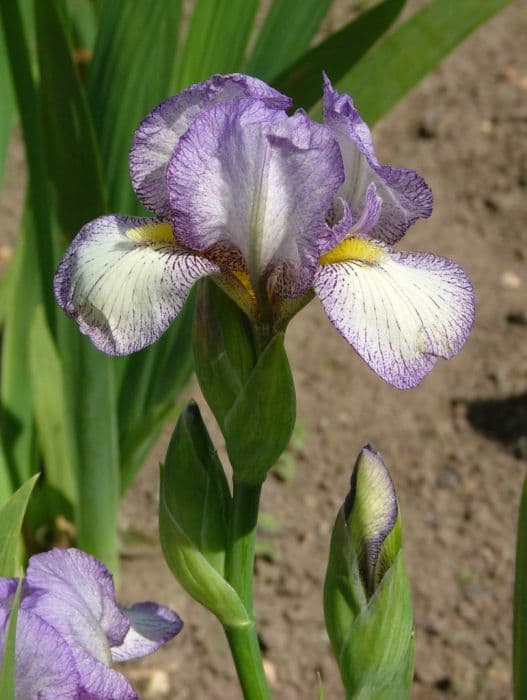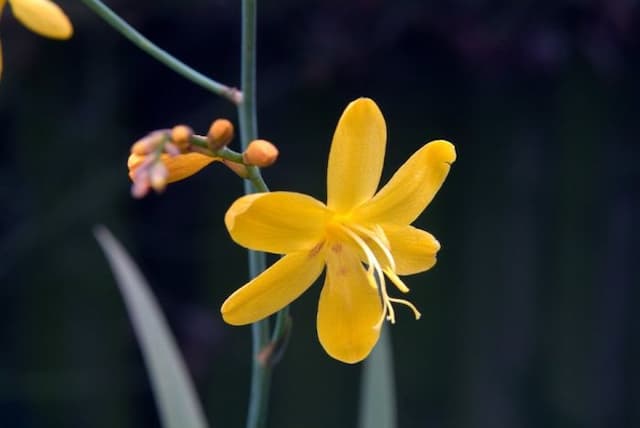Iris Iris 'Lucy's Gift' (MTB)

ABOUT
Iris 'Lucy's Gift' (MTB), commonly known as iris, showcases a striking appearance with a blend of colors that make it a captivating addition to any garden. The plant bears elegant flowers, characterized by their typical iris form which includes both upright standing and downward curving petals, referred to as standards and falls, respectively. The blooms exhibit a rich color palette, often with a combination of shades that can include purples, blues, yellows, and whites. Each petal may have intricate veining or splashes of contrasting colors, which adds to the complex beauty of the bloom. The falls often display a beard-like feature, which is an area of short hairs extending from the center of the petal. This beard is usually in a contrasting color, giving the flowers a dramatic and eye-catching appearance. Generally, the flowers have a classic, yet showy look with a delicate fragrance that entices both garden admirers and pollinators alike. The foliage of Iris 'Lucy's Gift' consists of long, sword-shaped leaves that grow upward and outwards from the base of the plant. These leaves are a deep, rich green and are often held in a fan-like formation which contributes to the overall aesthetic appeal of the iris. During the blooming season, the flowers emerge on slim, sturdy stems that rise gracefully above the foliage, showcasing the flowers in all their glory.
About this plant
 Names
NamesFamily
Iridaceae
Synonyms
Miniature Tall Bearded Iris, MTB Iris
Common names
Iris 'Lucy's Gift' (MTB)
 Toxicity
ToxicityTo humans
The Miniature Tall Bearded Iris, commonly known as the Iris, may have toxic properties. If ingested, parts of the Iris can cause irritation to the gastrointestinal tract. Symptoms may include stomach pain, nausea, vomiting, and diarrhea. In extreme cases, it could lead to more serious consequences such as dehydration from the gastrointestinal distress.
To pets
The Miniature Tall Bearded Iris, commonly known as the Iris, is considered toxic to pets. Eating parts of the Iris plant can cause symptoms such as drooling, lethargy, vomiting, diarrhea, and in some cases, abdominal pain. The severity of the symptoms can vary depending on the amount consumed and the size of the pet. Ingesting large quantities can lead to more serious health issues.
 Characteristics
CharacteristicsLife cycle
Perennials
Foliage type
Deciduous
Color of leaves
Green
Flower color
Purple
Height
1.5-2 feet (45-61 cm)
Spread
1-1.5 feet (30-45 cm)
Plant type
Bulb
Hardiness zones
3-9
Native area
Cultivar
Benefits
 General Benefits
General Benefits- Aesthetic Appeal: The Iris 'Lucy's Gift' adds vibrant color and visual interest to gardens with its striking flowers.
- Garden Variety: This miniature tall bearded iris is suitable for smaller gardens or limited spaces, offering versatility in landscaping.
- Easy Maintenance: Irises are generally low-maintenance plants, making them suitable for gardeners of all skill levels.
- Drought Tolerance: Once established, irises can tolerate periodic droughts, reducing the need for constant watering.
- Pest Resistance: Iris 'Lucy's Gift' is resistant to many common garden pests, promoting a healthier garden environment.
- Long Bloom Time: With proper care, this iris can have a lengthy blooming season, providing extended enjoyment of its flowers.
- Perennial Growth: As a perennial, the Iris 'Lucy's Gift' will return year after year, providing long-term value to the garden.
- Attracts Pollinators: The flowers can attract pollinators such as bees and butterflies, which are beneficial for the garden ecosystem.
- Propagates Easily: Can be propagated by division, allowing gardeners to expand their iris collection or share with others.
- Seasonal Interest: Provides springtime interest, as it is one of the earlier flowering perennials in many regions.
 Medical Properties
Medical PropertiesThis plant is not used for medical purposes.
 Air-purifying Qualities
Air-purifying QualitiesThis plant is not specifically known for air purifying qualities.
 Other Uses
Other Uses- Crafting Dyes: The Iris 'Lucy's Gift' can be used to create natural dyes for fabrics, with different parts of the plant yielding a variety of shades.
- Photography Subjects: Irises are popular among photographers due to their striking appearance, making them a frequent subject for botanical photography.
- Eco-Friendly Confetti: Dried petals of the Iris can serve as a biodegradable alternative to traditional paper or plastic confetti at events.
- Garden Design: Irises can be used in water-wise gardens as they require minimal watering once established, helping to conserve water resources.
- Artistic Inspiration: The unique shape and colors of the Iris can inspire artists to create paintings, illustrations, and fabric prints.
- Culinary Garnish: Although it is not common, the petals of some Iris varieties may be crystallized or used fresh to garnish desserts and salads.
- Perfumery: The scent of some Irises is used to craft perfumes, although primarily from their rhizomes rather than the flowers themselves.
- Scented Sachets: Dried Iris flowers can be included in scented sachets to freshen up closets and drawers.
- Educational Use: Irises can be used by educators to teach students about plant biology, hybridization, and the importance of biodiversity.
- Soil Erosion Control: The Iris's extensive root system can help stabilize soil, making it useful for planting in areas prone to erosion.
Interesting Facts
 Feng Shui
Feng ShuiThe Iris is not used in Feng Shui practice.
 Zodiac Sign Compitability
Zodiac Sign CompitabilityThe Iris is not used in astrology practice.
 Plant Symbolism
Plant Symbolism- Faith - Irises often symbolize faith, reflecting the trust and belief in a higher power or the confidence in a friend or loved one.
- Honor - The Iris is a symbol of honor and is often associated with royalty and respect.
- Wisdom - This flower can also represent wisdom, perhaps due to its three petals which can be seen as symbolizing wisdom, confidence, and valor.
- Hope - As a spring flower, the Iris brings hope by signaling the arrival of new beginnings and the end of winter's cold.
- Valor - In some historical contexts, Irises are associated with bravery and valor, often used to recognize the courageous achievements of individuals.
 Water
WaterMiniature tall bearded iris, commonly referred to as an Iris 'Lucy's Gift', should be watered deeply and infrequently to mimic their natural dry summer conditions. Established plants typically need watering every two weeks during the growing season. Ensure that about a gallon of water reaches the root zone each time you water. Newly planted irises may require more frequent watering, about once a week, to help establish their root systems. It's best to water in the morning so the foliage can dry during the day, as wet leaves can lead to disease. Reduce watering after blooming and during dormancy in the fall and winter.
 Light
LightMiniature tall bearded iris thrive in full sun conditions, meaning they require at least six hours of direct sunlight each day. An ideal location would be an east-facing or south-facing spot that receives morning sunlight and some afternoon shade, especially in regions with very hot summers. These irises can tolerate full sun throughout the day, but in particularly hot climates, some light afternoon shade is beneficial.
 Temperature
TemperatureIdeally, miniature tall bearded iris enjoys a temperature range between 55°F and 75°F. They can tolerate temperatures down to 20°F and up to 90°F, but prolonged exposure beyond these limits can be harmful. The moderate climate promotes optimal growth and flowering, while extreme heat or cold can stress the plant.
 Pruning
PruningMiniature tall bearded iris should be pruned to remove spent flower stems after blooming and to cut back any damaged foliage. This not only helps to maintain an attractive plant but also prevents disease. Pruning in late summer allows the plant to harden off before winter. Annual thinning or dividing of the rhizomes in late summer is often recommended to prevent overcrowding and encourage vigorous blooming.
 Cleaning
CleaningAs needed
 Soil
SoilFor the Miniature Tall Bearded Iris, a well-draining soil mix with a slightly acidic to neutral pH of 6.5 to 7 is best. Incorporate compost or aged manure and sand to improve drainage.
 Repotting
RepottingMiniature Tall Bearded Irises typically do not need to be repotted often. They should be divided and repotted every 3-4 years to maintain vigor and flower production.
 Humidity & Misting
Humidity & MistingMiniature Tall Bearded Irises prefer moderate humidity levels but are quite adaptable to various conditions as long as they are not in overly wet or humid environments.
 Suitable locations
Suitable locationsIndoor
Ensure bright light, proper drainage, and cool, dry winter conditions.
Outdoor
Plant in full sun, well-drained location; mulch lightly.
Hardiness zone
3-9 USDA
 Life cycle
Life cycleThe Iris 'Lucy's Gift' (Miniature Tall Bearded or MTB Iris) starts its life cycle when the seeds germinate in late spring or early summer, after experiencing a period of cold stratification. Sprouts emerge, developing into small plants with characteristic narrow, sword-like leaves. The plants enter a vegetative growth phase, establishing a strong root system and multiplying through rhizomes that spread underground. In the second or third year, the plant reaches maturity and produces tall, slender stems adorned with elegant, colorful flowers, blooming typically in late spring to early summer. After flowering, seed pods develop, which eventually dry and release seeds, or the plant continues to propagate vegetatively. The iris enters a period of dormancy in late autumn, with foliage dying back, and the rhizomes resting until the next growing season.
 Propogation
PropogationPropogation time
Spring-Early Summer
The most popular method of propagating the Iris 'Lucy's Gift', which is a type of Miniature Tall Bearded Iris (MTB), is through division of its rhizomes. This is best done after the flowering period, typically late summer to early fall. Gardeners should carefully dig up the clumps of irises and gently separate the rhizomes by pulling them apart, making sure each division has one or more fan of leaves and a section of roots. The divided rhizomes can be replanted in a well-draining soil mix, setting them so that the top of the rhizome is slightly exposed to the air. This encourages new growth and helps prevent rot. It's important to water these new plantings adequately to help establish them, but care should be taken not to overwater as irises are prone to root rot if left in soggy soil.









